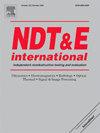Detection of debonding in stiffened composite panels by acoustic nonlinear response of broadband ultrasonic guided waves
IF 4.5
2区 材料科学
Q1 MATERIALS SCIENCE, CHARACTERIZATION & TESTING
引用次数: 0
Abstract
Debonding defects in the bonding layers of stiffened composite panels pose significant safety risks. However, they are challenging to detect due to their deep location and complex geometry, where conventional linear ultrasonic methods often fail. This study presents a broadband nonlinear ultrasonic guided wave approach for accurate debonding imaging. Chirp guided wave mixing (CGWM) is employed to excite broadband signals and effectively eliminate time-consuming signal processing. Defects are detected by analyzing three types of nonlinear components: second-harmonic generation (SHG), sum-frequency harmonic (SFH), and difference-frequency harmonic (DFH) responses. Results demonstrate that while linear ultrasonic detection struggles with deep debonding, all nonlinear ultrasonic components enable successful defect identification and imaging. Crucially, SFH and DFH allow efficient frequency-domain filtering, significantly reducing computational time compared to time-frequency domain processing required for SHG. Furthermore, the CGWM technique enhances nonlinear source behavior at defects while minimizing spurious nonlinearities from instruments.
宽带超声导波非线性声响应检测加筋复合材料板的脱粘
加筋复合板粘接层的脱粘缺陷存在较大的安全隐患。然而,由于其深层位置和复杂的几何形状,它们的检测具有挑战性,而传统的线性超声方法往往失败。本研究提出一种宽频带非线性超声导波方法用于精确的脱粘成像。利用啁啾导波混频(CGWM)对宽带信号进行激励,有效地消除了耗时的信号处理。通过分析三种非线性分量:二次谐波(SHG)、和频谐波(SFH)和差频谐波(DFH)响应来检测缺陷。结果表明,当线性超声检测与深度脱粘斗争时,所有非线性超声分量都能够成功地识别和成像缺陷。重要的是,SFH和DFH允许有效的频域滤波,与SHG所需的时频域处理相比,显著减少了计算时间。此外,CGWM技术增强了缺陷处的非线性源行为,同时最大限度地减少了仪器产生的伪非线性。
本文章由计算机程序翻译,如有差异,请以英文原文为准。
求助全文
约1分钟内获得全文
求助全文
来源期刊

Ndt & E International
工程技术-材料科学:表征与测试
CiteScore
7.20
自引率
9.50%
发文量
121
审稿时长
55 days
期刊介绍:
NDT&E international publishes peer-reviewed results of original research and development in all categories of the fields of nondestructive testing and evaluation including ultrasonics, electromagnetics, radiography, optical and thermal methods. In addition to traditional NDE topics, the emerging technology area of inspection of civil structures and materials is also emphasized. The journal publishes original papers on research and development of new inspection techniques and methods, as well as on novel and innovative applications of established methods. Papers on NDE sensors and their applications both for inspection and process control, as well as papers describing novel NDE systems for structural health monitoring and their performance in industrial settings are also considered. Other regular features include international news, new equipment and a calendar of forthcoming worldwide meetings. This journal is listed in Current Contents.
 求助内容:
求助内容: 应助结果提醒方式:
应助结果提醒方式:


